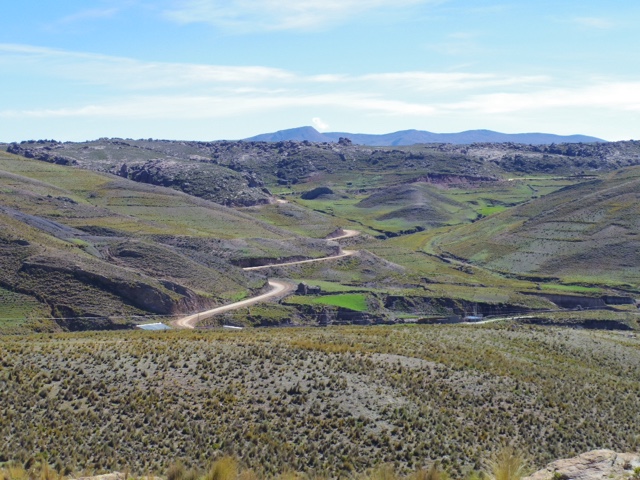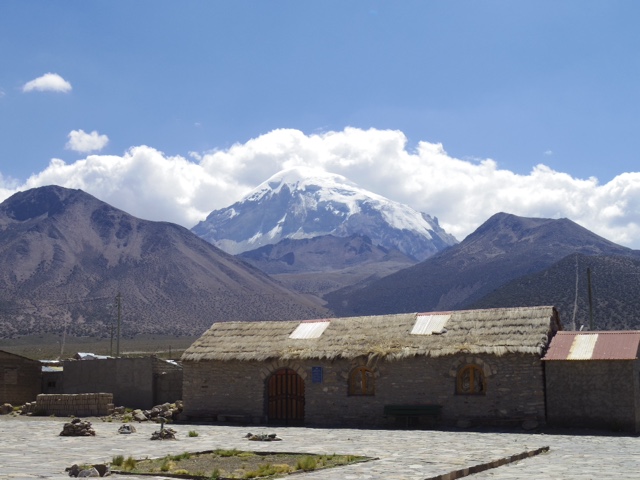We realize it's been a while since our last post, but we've had a somewhat hectic week. We're back in Cochabamba now, resting and recovering while staying with our friend Hache, world cyclist and warmshowers host. Check out his adventures at cyclingpeace.org
The final descent was just as steep as all the ups and was very painful for the wrists and elbows! It's always a bummer when the descent is less fun than the climb... At 6:30, we rolled into Torotoro at last, dreaming of a pollo broaster (fried chicken).
To finish the story of our most recent trip:
Thursday, Feb 18: Acasio to wild camp after Churutaca, 20km
We set off from our riverside campsite when the rain cleared, and immediately came upon one of the steepest climbs we've faced. Our climbs had been hard up to this point, but generally more for length and road surface than for steepness.We made it up, but soon realized that there was much more ahead of us: tightly turning switchbacks straight up a mountain. We'd finally found steeper than 10% grades, on rocky, loose dirt!
Looking back down to the valley where we camped.
After a few hours, we reached a small town, where we chatted with a storekeeper while devouring some snacks. She told us that her mother used to walk to Torotoro sometimes, leaving at 5am and arriving at 8am. This was on a more direct footpath, but we assumed we'd make it in a similar amount of time. The woman told us there was one short steep section ahead but that the rest would be easy. Little did we know how wrong that would be...
Still smiling at that point!
We descended a few kilometers, only to reach an even steeper uphill than what we'd already climbed. We forced our way up, grinding at the pedals and pushing in the rocky streambed-like sections.
Each time we reached a "summit", the road would descend briefly to cross a stream, then immediately go straight up again. We rode until 3pm, at which point, absolutely spent, we decided to make camp.
All those people telling us we'd arrive in Torotoro easily that afternoon were such liars!
Friday, Feb 19: Churutaca to Torotoro, 45km
In the morning, we set off during a brief dry spell, knowing that we had to make it to Torotoro because we didn't have much more food. The rain soon returned, which kept us cool but also soggy for most of the day. The road was also even more like a river:
And just as steep as the day before! The one good thing about the rain was that there was plenty of fresh water flowing, so we never had to carry more than a bottle at a time. After the altiplano drought, this felt like heaven!
Unfortunately, my, Lucy's, knee had started bothering me the first day, and the pain continued to worsen throughout the morning. I kept pushing along, knowing we had little other choice, but eventually the climbing became too difficult for it and I knew I had to stop or risk serious injury. For the last hill, Adie pushed both the bikes in a tiring relay, while I limped up.
Thankfully, the other side brought our first ridge section of the journey, allowing us to rest our tired muscles for a bit. At 3pm, we had made it 12km!
The only two cars we saw all day passed us while we were eating a late lunch under a weak sun, and told us that it was 25km of mostly descent to Torotoro. It turned out there were still two hours' worth of ups and downs before the real descent, but at least there were beautiful rocks to look at!
We found the pollo broaster, and a nice hostel with a comfortable bed! Unfortunately, that night, my stomach illness reared its head again. I spent the next day in bed, and even broke my 14-year streak of never throwing up. (I evaded seasickness on the tall ships, but Bolivia did me in!) On Sunday, we went to the health clinic, where they put me on an IV for fluid replacement. I'm now waiting for lab results to know whether I still have salmonella, in addition to the stomach parasite that I am dealing with.
On Monday, I finally felt well enough for us to go out and explore Torotoro a bit, which is a national park filled with caves, dinosaur footprints, canyons and waterfalls. We went for a hike to a beautiful waterfall in a canyon, where I enjoyed soaking my hurt knee in the cold water!
The next day, Tueday, we headed for Cochabamba on a bus. This was mainly because of my injury, but it saved us from having to bike over 100km on cobbled roads! The bus ride was long and hot, and our bikes were injured a bit by all the farm produce that was shoved in the cargo space, but we eventually made it to the city and up the giant hill to Hache's house.
Alix Wicker is visiting us here for a few days! We're searching for a decent bike option for her and discussing plans for the future. I'm not sure when or how Adie and I will leave Cochabamba, but we expect to be here until my knee is healed. At least it's affording us the opportunity to eat lots of good food for a change!


























































